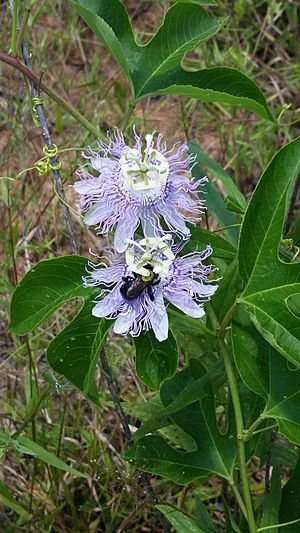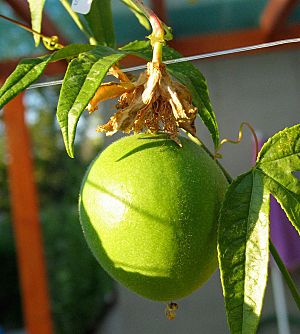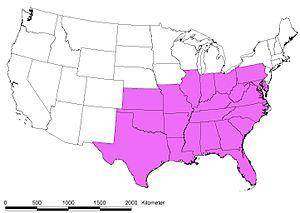Maypop facts for kids
Quick facts for kids Maypop |
|
|---|---|
 |
|
| Flower | |
 |
|
| Fruit | |
| Scientific classification | |
| Genus: |
Passiflora
|
| Species: |
incarnata
|
 |
|
The Passiflora incarnata, also known as maypop or purple passionflower, is a fast-growing plant. It's a type of perennial vine, which means it lives for more than two years. It has stems that can climb or trail along the ground. The maypop is part of the Passiflora family. It has big, fancy flowers with unique parts called styles and stamens.
This plant is one of the toughest passionflower types. You can find it growing wild in the southern United States. People also grow it in gardens because of its tasty fruit and pretty bluish-purple flowers. The fruit of Passiflora incarnata has many seeds. Each seed is covered in a juicy part called an aril. This juice is edible and can be eaten fresh or used to flavor foods and drinks.
Contents
What the Maypop Looks Like
The stems of the maypop vine can be smooth or a bit fuzzy. They are long and spread out, with many tendrils that help the plant climb. Its leaves usually have three lobes, like fingers on a hand, but sometimes they have five. They are about 6 to 15 centimeters long. At the base of each leaf, there are two special glands.
The flowers have five bluish-white petals. They also have a cool structure called a corona, which looks like a crown of white and purple threads between the petals and the stamens. These large flowers usually bloom in July. Pollination happens when insects like bumblebees and carpenter bees visit the flowers. The maypop flowers cannot pollinate themselves.
The fruit, also called a maypop, is a yellowish, oval-shaped berry. It's about the size of a hen's egg. When it's young, it's green, but it turns yellow as it ripens. If you step on a ripe fruit, it might make a "pop" sound! This is one reason for its name. Another reason is that its roots stay hidden underground all winter. Then, the plant "pops" out of the ground by May, even after snow.
Many lepidoptera (butterflies and moths) use the maypop as food for their larvae (caterpillars). This includes the zebra longwing, Gulf fritillary, and Julia butterflies. Many wild animals also love to eat the fruit.
You can find maypops growing in thick bushes, disturbed areas, near riverbanks, and along roadsides or railroads. They love sunny spots and won't grow well in shady forests.
The Cherokee people in Tennessee called this plant ocoee. The Ocoee River and valley are named after it. The maypop is even the state wildflower of Tennessee. For thousands of years, the maypop was an important food and medicine for the Cherokee. It is still a special part of their history today.
Growing Maypops
Passiflora incarnata is easy to grow. In its native areas, it's a common garden plant that doesn't need much care. You can train it to grow on fences or arbors. The wild maypop is a fast-growing vine that spreads quickly. It can cover the ground in thick patches in just a few days if the weather is good.
These plants need lots of sunlight, at least half a day of direct sun. They grow best in soil that drains water well. However, they can also handle soil that is sometimes wet or a bit acidic. Maypops are good at surviving dry periods. You can plant them any time of year in warmer areas (hardiness zones 7–11). It's best to leave about 90 to 150 centimeters between plants.
It takes about one to two years for the plants to start producing fruit. Each flower only lasts for about one day. Then, the fruit grows over two to three months. The amount of fruit you get depends on how big and old the vine is. Some plants can produce 10 to 20 fruits per vine. You can collect seeds in the fall after the fruit starts to shrivel.
The flowers are perfect for bumblebees and may also attract ruby-throated hummingbirds. As these animals look for nectar, pollen from the flower sticks to their backs or faces. This helps the pollen move to the sticky part of the flower, allowing new fruits to grow.
Sometimes, Passiflora incarnata can grow so fast that it becomes a weed in farm areas. This means it can spread quickly and take over other plants. To stop it from spreading too much, people often remove the new shoots (called suckers) that grow from the roots. It also helps to train the vines to grow on trellises or fences.
Maypop in Traditional Uses
Past Uses and Folk Beliefs
Historically, people used the maypop as a herbal remedy. They believed it could help people feel calm, sleep better, or manage high blood pressure. In traditional practices, passionflower was thought to help with various health issues.
The dried parts of the maypop plant are even mentioned in official books that list medicines, like the European and British Pharmacopoeias. In North America and South America, people made tea from the roots as a general health tonic. The U.S. Food and Drug Administration (FDA) once approved it as an over-the-counter sleep aid. However, in 1978, they removed this approval because companies didn't provide enough proof that it was safe and worked well.
Safety Information
A review in 2013 found that the maypop herb is generally safe to use. One study showed that taking 800 milligrams of a dried extract daily for eight weeks to help with feeling anxious seemed safe.
Maypop is also used as a natural flavor in food. It is generally recognized as a safe substance (GRAS) for this purpose. It's also listed in Europe as an additive for animal feed.
Eating Maypops
The maypop has edible fruits that can be used to make jams, jellies, and desserts. The juice is a popular flavor for drinks. You can use it fresh as a substitute for the passion fruit grown in South America, Passiflora edulis, which has similar-sized fruit.
You can eat the fruit right from the plant. The Cajuns, a group of people in Louisiana, called it "liane de grenade," meaning "pomegranate vine." When it's fully ripe, it has a slightly sweet and tart taste and a pleasant smell. The fruits from the Passiflora family are known for being aromatic (smelling good) and sweet. This makes them great for eating fresh or for adding flavor to other foods.
See also
 In Spanish: Flores de la pasión para niños
In Spanish: Flores de la pasión para niños

